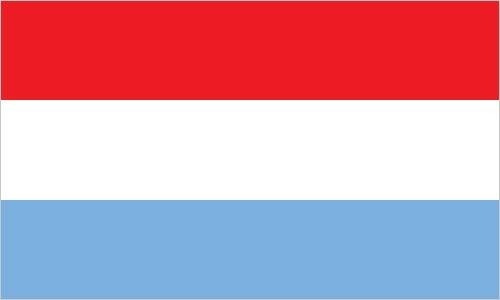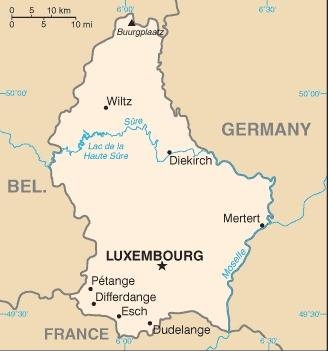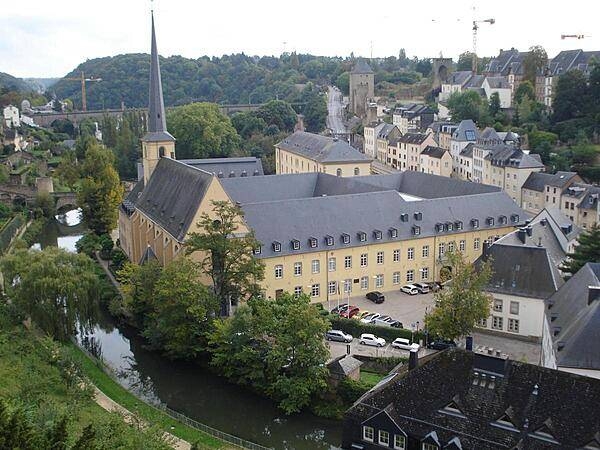90 Luxembourg

Three equal horizontal bands of red (top), white, and light blue. Similar to the flag of the Netherlands, which uses a darker blue and is shorter. The coloring is derived from the Grand Duke’s coat of arms (a red lion on a white and blue striped field).
Flag courtesy of the CIA World Factbook

Map courtesy of the CIA World Factbook

St. John’s Church was originally built in 1606. It became the place of worship for Benedictine monks from Neumunster Abbey in the Grund District of Luxembourg City. The present church dates from the late 17th century and has a fine baroque interior. One of its greatest treasurers is a Black Madonna created in the 14th century. The abbey was used as a prison from the mid-19th century to the late-20th century.
Photo courtesy of the CIA World Factbook
Government
According to Britannica, the grand duchy is a constitutional monarchy with hereditary succession. Executive power authority lies with the grand duke, who appoints the prime minister. The powers of the grand duke are primarily formal, however. Actual executive power lies with the prime minister and his ministerial council, or cabinet, who are responsible to the Chamber of Deputies. The members of this legislative assembly are elected by popular vote to five-year terms. Voting by all adult citizens, begun in 1919, is compulsory. Legislative elections have usually given rise to coalition governments formed alternatively by two of the three major parties: the Christian Social People’s Party (Chrëschtlech Sozial Vollekspartei; CSV), the Socialist Workers’ Party of Luxembourg (Lëtzebuergesch Sozialistesch Arbechterpartei; LSAP), and the Democratic Party (DP). In addition, a Council of State named by the grand duke functions as an advisory body. It is consulted on all draft legislation, advises the grand duke on administrative affairs, and serves as a supreme court in case of administrative disputes.
There are also three advisory bodies that are consulted before the passage of legislation affecting their particular area of the national life. The first of these consists of six confederations, three of which represent employers (commerce, guilds, and farmers) and three of which represent labour (workers, private employees, and civil servants). The second advisory group, the Social and Economic Council, has become a major committee for the examination of all projects. The third, the Immigration Council, advises the government on problems involving housing and the political rights of immigrants.
Justice is in the hands of magistrates appointed for life by the grand duke, the final appeal lying with the Superior Court of Justice. In the criminal court of assizes, six magistrates sit as jury as well as judge.
Luxembourg is divided administratively into three districts, each of which is headed by a commissioner appointed by the central government. Each district is in turn divided into cantons and subdivided into communes, or municipalities. Public works, health, and education are among the responsibilities of the communes, each of which is governed by an elected council and a mayor. These bodies also maintain liaison with the central government and act as its local agents.
Directorate of Civil Aviation (DAC)
The Directorate of Civil Aviation (DAC) is the competent authority of the Grand Duchy of Luxembourg in matters relating to aviation safety and security.
Airspace
SkyVector – Google Maps – ADS-B Exchange
ICAO countries publish an Aeronautical Information Publication (AIP). This document is divided into three parts: General (GEN), En Route (ENR) and Aerodromes (AD). ENR 1.4 details the types of airspace classes they chose to adopt from classes A through G.
Drone Regulations
Interactive map – GEOPORTAIL
Advanced Air Mobility (AAM) Regulations & Policies
Bilateral agreements facilitate the reciprocal airworthiness certification of civil aeronautical products imported/exported between two signatory countries. A Bilateral Airworthiness Agreement (BAA) or Bilateral Aviation Safety Agreement (BASA) with Implementation Procedures for Airworthiness (IPA) provides for airworthiness technical cooperation between the FAA and its counterpart civil aviation authorities.
Reciprocal acceptance of aviation safety-related approvals and services with the European Union Aviation Safety Agency (EASA) and Member States of the European Union are primarily governed by the U.S. – European Union Safety Agreement.
Advanced Air Mobility (AAM) News
None found by the author.
However, should you, the reader, happen to stumble across something to the contrary, please email the author at FISHE5CA@erau.edu and you may be mentioned in the ACKNOWLEDGEMENTS section of this book by way of thanks for contributing to this free eBook!
Short Essay Questions
Scenario-Based Question
You have been hired by a Drone Startup Company. Your boss has immediately assigned this job to you.
They need you to prepare a one-page memo detailing the legalities of using a drone to film St. John’s Church in Luxembourg, pictured above.
They need you to mention any national laws and local ordinances.
They specifically want to know what airspace (insert pictures) you will be operating in and whether or not you need an airspace authorization.
Does it matter whether or not you are a citizen of the country?
Lastly, there is a bonus for you if, as you scroll through this chapter, you find any typos or broken links!
Short Essay Questions
- What are the drone categories?
- How is registration addressed?
- How is remote ID addressed?
- What are the model aircraft rules?
- What are the commercial drone rules?
- Are there waivers or exemptions to the rules? If so, for what?
- Would you share a link to an interactive airspace map?
- How is BVLOS addressed?
- How can you fly drones at night?
- How can you fly drones over people?
- Where do you find drone NOTAMs?
- What are the rules for drone maintenance?
- What are the rules for an SMS program?
- What are some unique rules not mentioned above?
- What are the C-UAS rules?
- What are the AAM rules?

